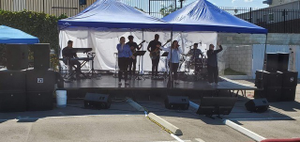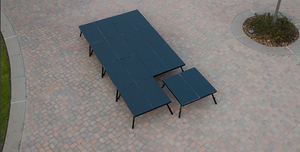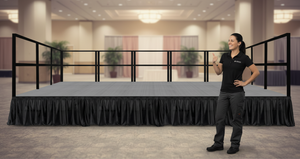Portable stages offer churches a flexible and cost-effective way to enhance worship experiences. Whether you're hosting a choir performance, a sermon, or a special event, a portable stage can be easily set up and customized to fit your needs.
Let's explore how to set up a stunning stage for your church service.
Introduction to Portable Stages for Churches
Portable stages provide a versatile solution to elevate your services and events. These adaptable platforms provide unmatched flexibility, allowing you to create different configurations for various occasions.
Whether it's a grand choir performance, a powerful sermon, or an intimate communion service, a portable church stage can be tailored to your needs. Plus, they're cost-effective and easy to store, making them a practical choice for any church.
Types of Portable Stage
Portable stages come in three main types: aluminum, lightweight and durable; wooden, classic and sturdy; plastic, budget-friendly and easy to clean.
Aluminum Stages
Lightweight and durable aluminum stage decks are popular for their easy assembly and portability. They offer a sleek, modern look.
Wooden Stages
Providing a classic and warm aesthetic, wooden stages are often chosen for their stability and sound quality. However, they are generally heavier than aluminum options and thus less convenient for portable staging.
Plastic Stages
Budget-friendly and easy to clean, plastic stages are a practical choice for many churches. While they might not offer the same level of durability as aluminum or wood, they are lightweight and versatile. They are quite popular for the portable staging of churches.
Choosing the Right Portable Stage for Your Church
Selecting the perfect portable stage involves careful consideration of several factors. Aluminum stages are lightweight, durable, and modern, while wooden stages offer a classic aesthetic and better acoustics. Plastic stages are budget-friendly but might lack durability.
When making your choice, prioritize size, weight, and load capacity to accommodate your church's needs. Consider the stage's intended use, frequency of the system, and available storage space. Additional features like ramps, handrails, and carpeted surfaces can enhance safety and appearance.
Assessing Your Church's Needs
Choosing the right portable stage involves a thorough understanding of your church's unique requirements. To make an informed decision, consider the following factors:
Evaluate Your Worship Style
- Traditional vs. Contemporary: Traditional services might require a more formal stage setup, while contemporary worship services might demand a flexible, adaptable space.
- Music Emphasis: If music is a central part of your worship, you'll need a stage large enough to accommodate instruments, choir, and soloists.
- Drama and Performance: Consider the frequency of theatrical productions or drama performances. A larger stage with more versatile configurations might be necessary.
Determine Stage Size and Configuration
- Congregation Size: The number of attendees will influence the stage's size and placement. A larger congregation might require a more prominent stage.
- Space Availability: Assess the available space in your sanctuary. Consider the stage's dimensions and whether it can be easily stored when not in use.
- Flexibility: Evaluate the need for a stage that can be reconfigured for different events, such as conferences, youth gatherings, or special occasions.
Consider Stage Height and Accessibility
- Visibility: Ensure the stage height provides adequate visibility for the entire congregation.
- Accessibility: If your church has members with mobility challenges, consider adding ramps or steps for easy access.
- Equipment Placement: Determine the optimal height for placing speakers, lights, and other equipment.
Assess Weight and Portability
- Storage Space: Evaluate the available storage area for the stage when it's not in use.
- Setup Time: Consider the frequency of stage setups and the time required for assembly and disassembly.
- Transportation: If the stage needs to be transported between locations, its weight and dimensions are crucial factors.
Budget Considerations
- Cost of the Stage: Determine your budget for purchasing portable stages.
- Additional Costs: Consider costs for accessories, such as ramps, handrails, and stage covers; this would help you be profitable in the long run.
- Long-Term Costs: Factor in maintenance and storage costs over time.
Safety and Regulations
- Load Capacity: Ensure the stage can safely support the weight of people, equipment, and decorations.
- Fire Safety: Check local fire regulations and safety standards for stage setups.
- Accessibility Standards: Comply with accessibility guidelines to accommodate people with disabilities.
By carefully considering these factors, you can select an outdoor portable stage from a reliable manufacturer that perfectly meets your church's needs and enhances your worship experience.
Setting Up a Portable Stage Platform
Setting up a portable stage with grand drum risers might seem daunting, but with careful planning and attention to detail, it can be a straightforward process. Always prioritize safety with guard rails and other things during the setup.
Unpacking and Assembling the Stage
Begin by carefully unpacking all components of the stage. Refer to the manufacturer's instructions for specific assembly steps. Typically, the process involves connecting individual stage panels using interlocking mechanisms or pins. Ensure all connections are secure before proceeding to the next step.
Safety First
Safety is paramount during the stage setup. Wear appropriate protective gear, such as gloves and safety shoes. Always follow the manufacturer's weight limits for the stage and use guard rails. Avoid overloading the platform when designing for churches. Have multiple people assist with the setup to prevent injuries.
Securing the Stage
Once assembled, it's crucial to secure the portable staging to prevent movement. An anchoring system provided by the manufacturer is used to attach the stage to the floor. If anchoring isn't possible, consider using heavy-duty stage tape to secure the stage's edges to the floor. Check all connections and fasteners to ensure stability.
Use portable stage platform railing to ensure the stage is safe for the performers and the audience.
Leveling the Stage
A level stage is essential for safety and aesthetics. Use the right stage equipment to determine if the stage is uneven. Adjust the stage's feet or use shims to correct any imbalances. For larger portable stages, consider using a laser level for precision. A portable staging system provides a safe environment and ample space for performers and attendees.
Enhancing the Stage Setup
Transform your stage and create from basic to breathtaking churches. Discover creative ways to enhance your portable stage systems and create a captivating worship environment with new sound equipment. You can also replicate this in the future.
Stage Decor and Aesthetics
Transform your portable stage into a visually appealing space by incorporating decorations that align with your church's aesthetic. Drapes, banners, bands, and floral arrangements can create a warm and inviting atmosphere at the venue. Event planners ensure all decorations are securely fastened for safety. When asked how to set up a portable stage platform for churches, you can always collaborate with experts.
Lighting and Sound
Proper lighting and sound placement are essential to expand and enhance the stage's impact. Position indoor lights to highlight performers without creating glare. Consider using portable risers for specific areas. Strategically place speakers indoors to ensure even sound distribution throughout the audience.
Creating Levels with Stage Risers
Add dimension and visual interest with modular components to your stage by using stage risers like a concert. Create room to accommodate instruments, highlight performers, or simply enhance the stage's overall appearance. Ensure risers are stable and secure.
Designing a Striking Backdrop
A visually appealing backdrop can significantly impact the stage's look. Choose a backdrop that complements your church's theme or the event. Fabric backdrops, printed designs, or even video walls can be effective options for the specific needs of your stand. Additionally, ensure the backdrop is securely hung and properly lit in risky venues. You can use pretty portable stage skirting to capture your audience’s attention.
Maintenance and Storage of Portable Stages
Extend the life of your small portable stage with proper care. Learn essential maintenance and storage tips to keep your investment in top condition.
Keep Your Stage in Top Shape
Regular cleaning and inspection are crucial for maintaining your portable stage's condition. Remove dirt, debris, and spills promptly. Regularly check for loose connections, worn components, or structural damage.
Protect Your Investment
To ensure your stage's longevity, avoid overloading it and distribute weight evenly over the panel. Store the stage in a cool, dry place away from direct sunlight and moisture. Cover it with a protective cover when not in use. For optimal storage, disassemble the modular stage if space permits to prevent warping and damage.
Conclusion
Portable platforms can transform a ground to your church's worship space. Choose the right stage for your needs, set it up safely, and maintain it well. Proper planning and care will ensure your stage is constructed to enhance your worship services and meet your unique needs for years to come. Consider your church's unique requirements and invest in a stage that elevates your worship experience.






